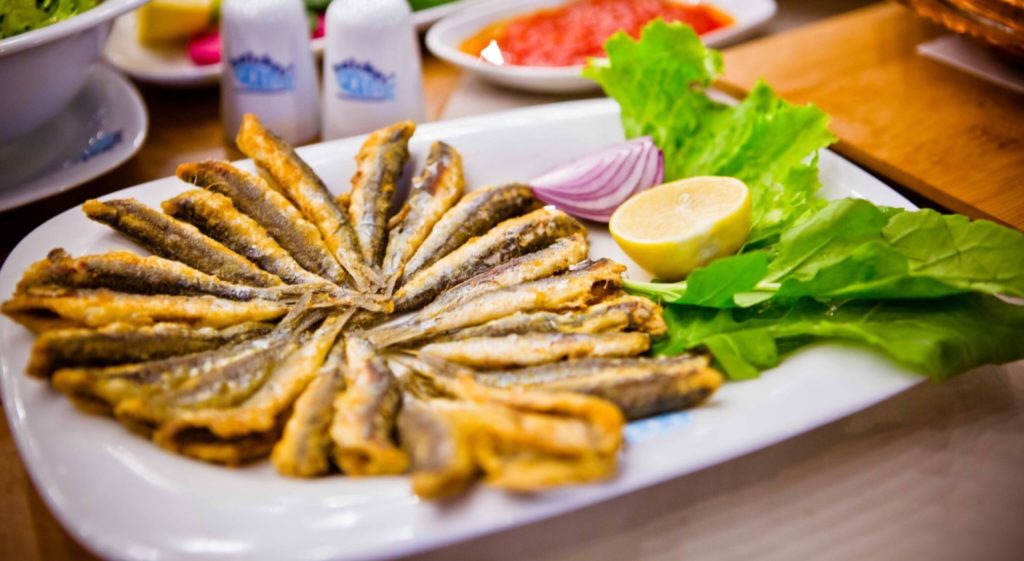Turkey’s national fish, hamsi, or anchovies is more than a fish for the locals of the Black Sea region and whether it is fried or canned, hamsi offers a feast for both humble and rich dinner tables …
Surrounded by the sea on three sides, Turkey has been blessed with an abundance of fish. Although fish is not considered a main source of food for Turks, the people living near the seas, especially those in the Black Sea region, are very creative in their kitchens when it comes to the sea dweller.
Turkey’s national fish
Hamsi, or Anatolian anchovies, could be considered Turkey’s national fish. Abundant in the Black Sea, especially during the winter, it is more than a simple sea creature for the people of the Black Sea region. Locals have become very attached to all things hamsi related and, as a result, the fish has become a significant part of life in the region. Poems and songs have been written about hamsi. Bards from the north even travelled around Anatolia singing songs about the glorious fish. In fact, an entire cuisine has been devoted to hamsi in northern Turkey, and the locals use it in almost every dish.

This silver, delicious beauty in all of its 12 to 15-centimetre glory is the tiny king of Turkish dinner tables. During the winter months, when the Black Sea is crawling with hamsi, this shiny little fish is quite a bargain.
There is a saying among native Black Sea people, “Foreigners eat hamsi without bones, but the people of the Black Sea eat it whole.” Indeed, most people eat hamsi without removing its bones, pan-fried whole.
Fried hamsi
Frying is the easiest way to prepare hamsi. Wash the hamsi and cover them with either regular flour or cornflour. Place them in a large well-oiled pan and fry for a couple of minutes on each side.

Hamsi with rice
Turks have always respected their past, and this is also the case when it comes to hamsi. This incredible fish was once the king of the Ottoman imperial kitchen, as well. Sultans preferred to eat it with a special kind of “pilav,” a dish made with rice. Although it is not as easy as the fried hamsi, Turks still cherish this tradition in their homes.
The Laz, an ethnic minority in the northeast of Turkey, live in the verdant Kaçkar Mountains that seem to crash right down into the Black Sea.
This recipe comes straight out of the Laz heartland
Hamsili pilav

Ingredients:
1 kg of fresh, whole anchovies
1.5 cups of white rice
1 large onion, finely chopped
1/3 cup currants
¼ cup pine nuts
2 tablespoons vegetable oil
½ cup chopped dill
Salt
Black pepper
Preparation:
Sautée the pine nuts in the vegetable oil on medium heat, add the finely chopped onions and keep cooking until the onions turn golden but still soft. Add the rice and continue cooking for a few minutes. Add the currants, dill, black pepper and salt. Mix well and add enough water to cover the mixture. Cook over low heat until the water has cooked off. The mixture is ready when the rice is still a bit “underdone” or “yarım pişmiş” (“half-cooked”),
Debone the anchovies and remove their guts, patting them flat to create mini filets (or, better yet, ask your fish seller to do the deboning for you). Cover the bottom and sides of a well-oiled oven tray or casserole dish with the anchovies. Spread half of the pilaf over the anchovies. Add another layer of anchovies on top of the stuffing and then spread the remaining pilaf on top of the fish, as if layering a cake. Finally, add one more layer of anchovies. Add enough water to cover the top layer of anchovies. Drizzle a little vegetable oil on the surface and bake at 200 degrees Celsius until the water has been completely absorbed by the rice or about 30 minutes.
To serve, use a sharp knife to score the pilaf’s top into square portions and then use a spatula to take the squares out of the tray.
Pickled hamsi
The people of the Black Sea have taken their love for the fish one step further by creating hamsi pickles.

Hamsi pickles (turşu) are quite easy to make and similar to any other pickles. After a thorough cleaning, the hamsi is put into glass jars or plastic cans and vinegar and oil are added. You can also put bay leaves and lemon in the jar. The pickles must be stored away from direct sunlight or in the fridge. Hamsi pickles can be stored unopened for more than a year.
Afiyet Olsun
You can find more hamsi recipes here
Sources: Daily Sabah/ Miraç Geyik//Istanbul Eats
This article was first published on 9 February 2020.








